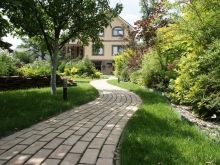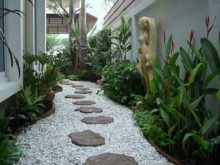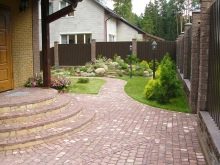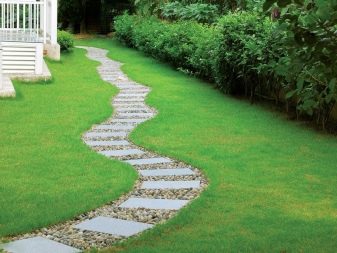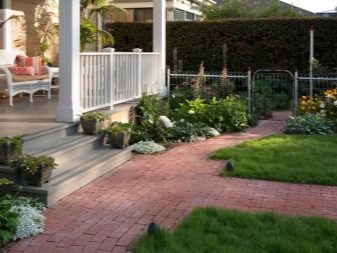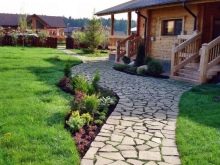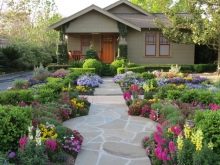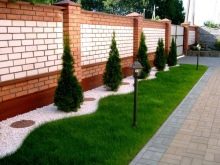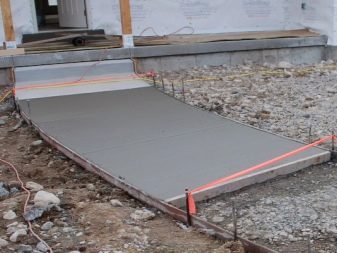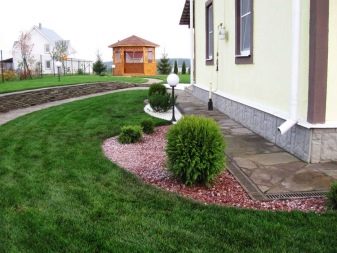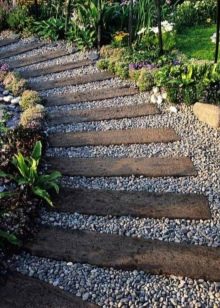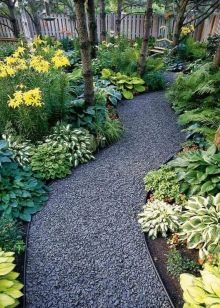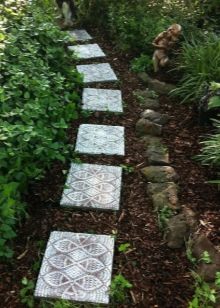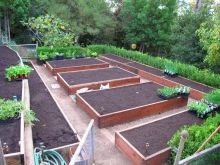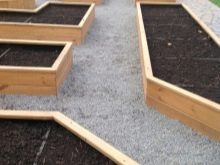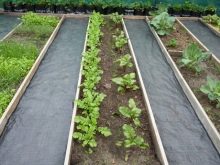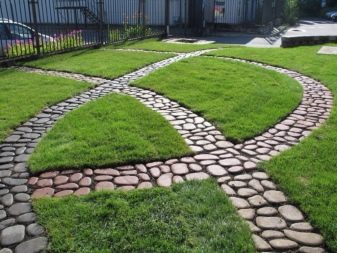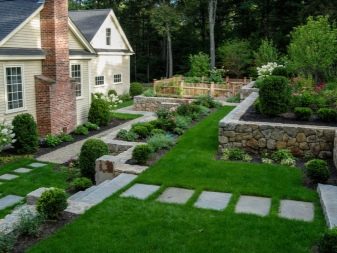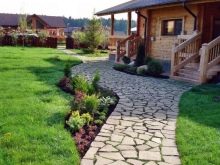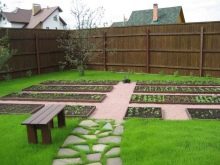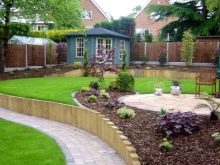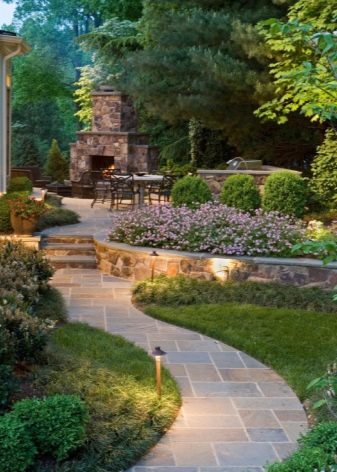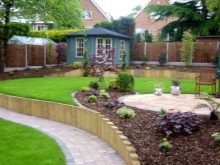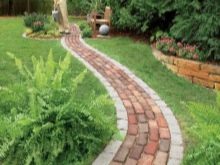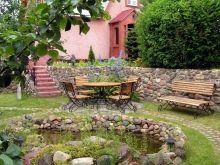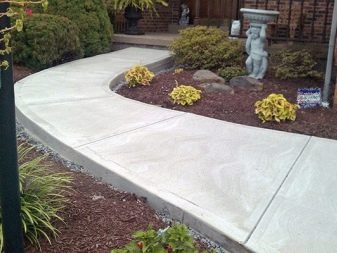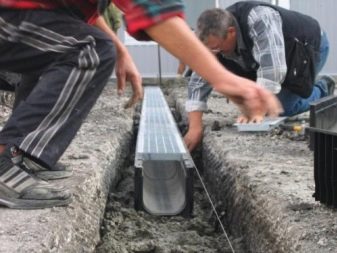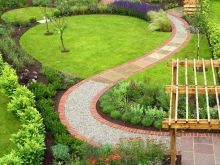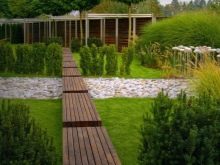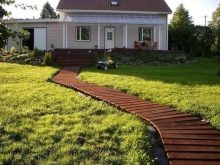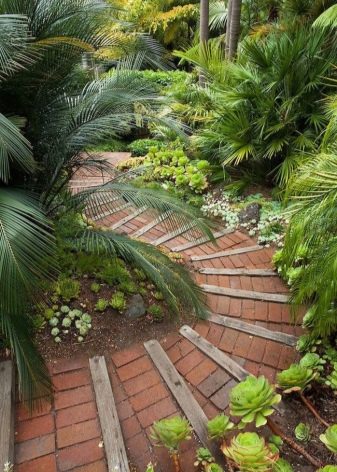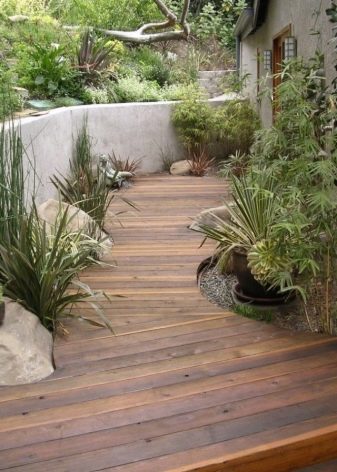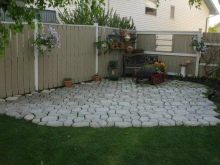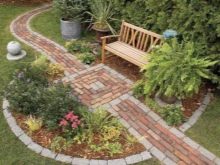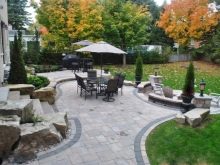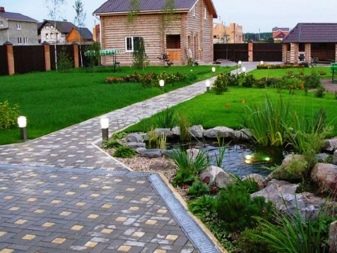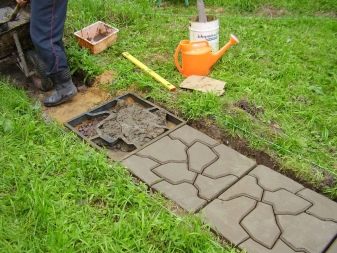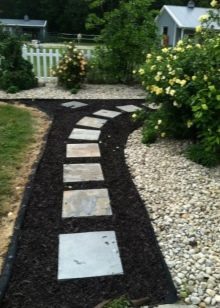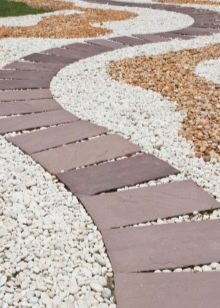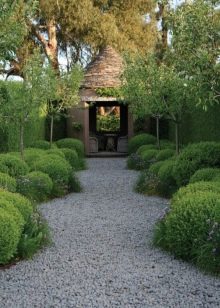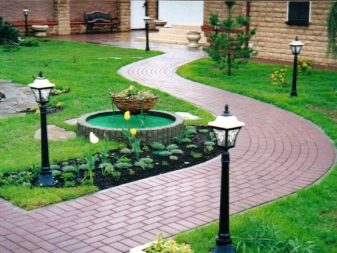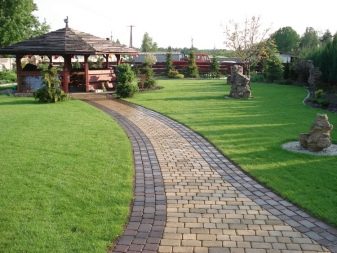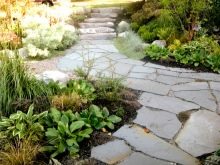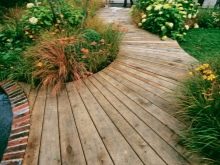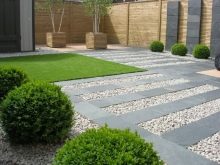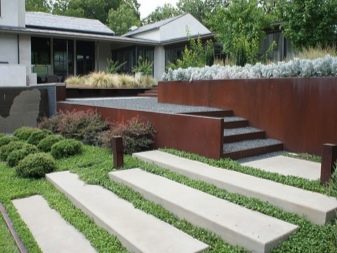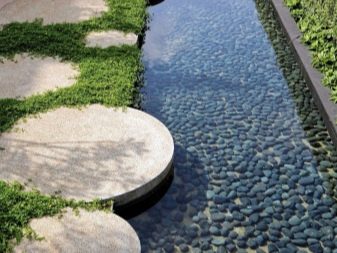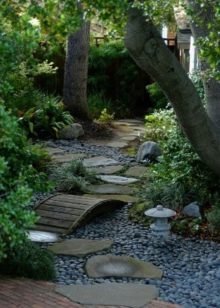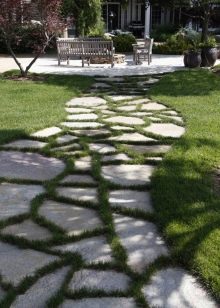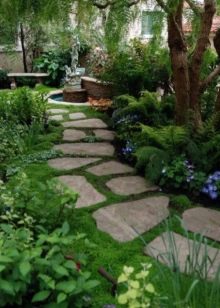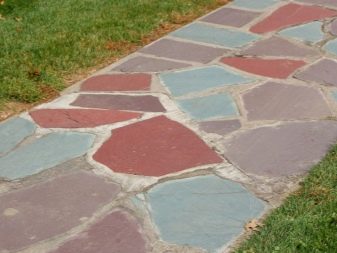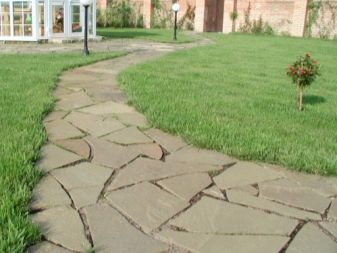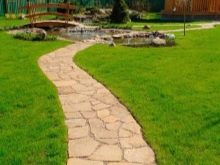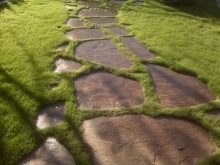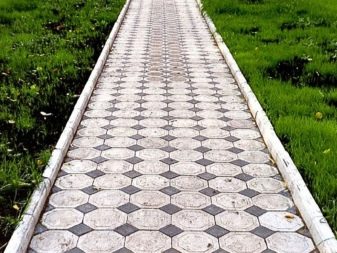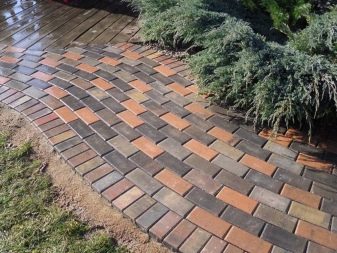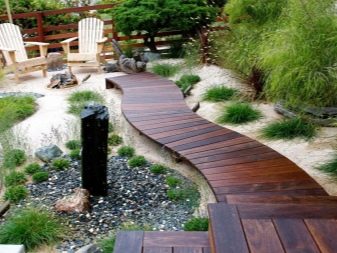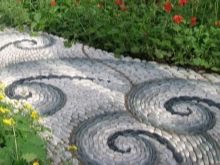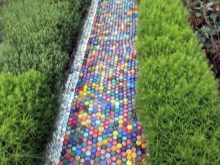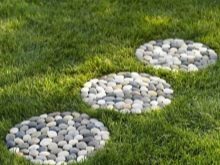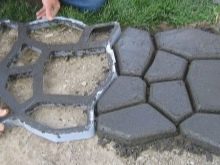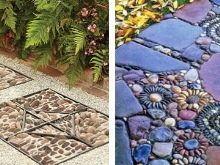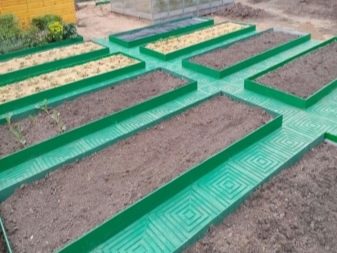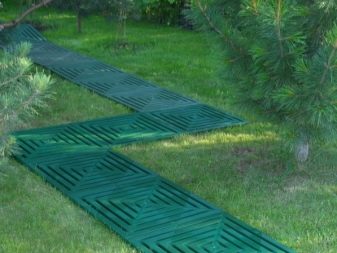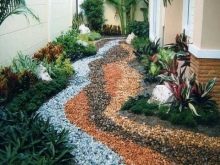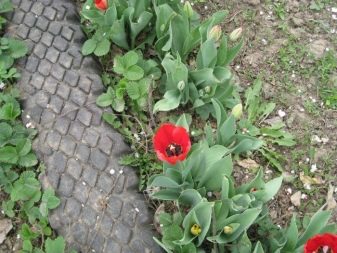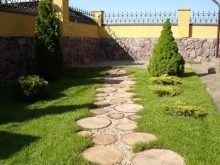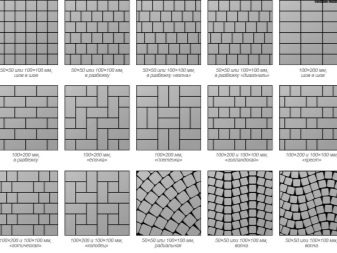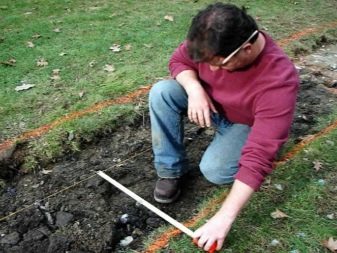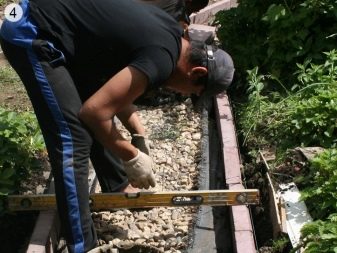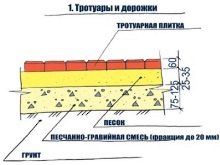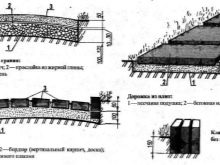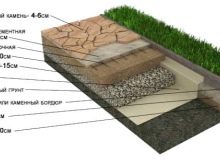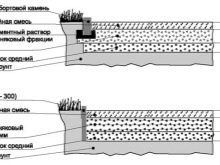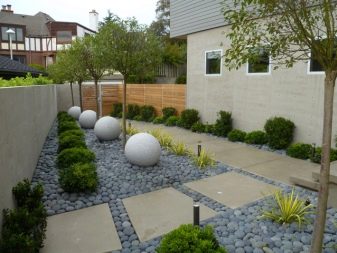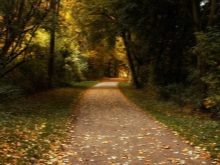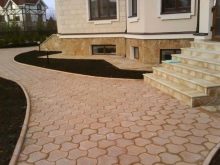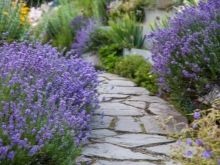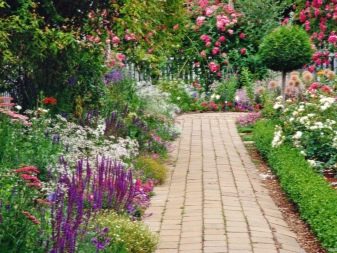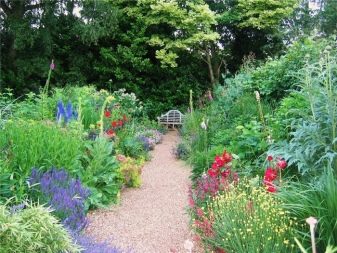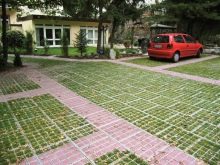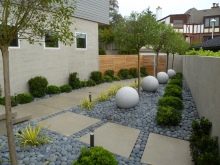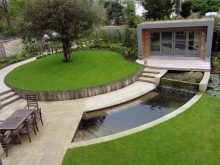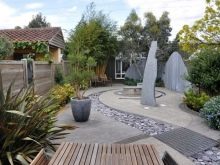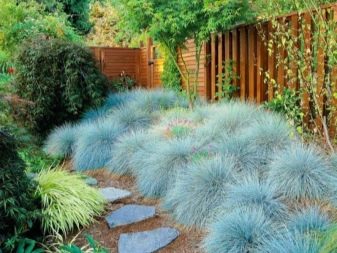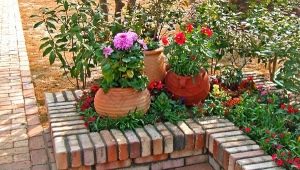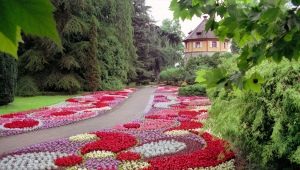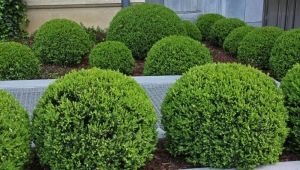Features clearance tracks in the country
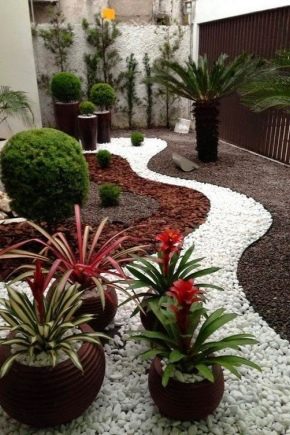
Increasingly, the cottage becomes a place of rest for family and friends. The plots are equipped with houses and outbuildings, recreation areas and flower gardens. There is a place for a vegetable garden, which acquires decorative qualities. All objects are connected by a network of communications - tracks. They allow you to avoid dirt, create convenience for agricultural work, walks in the fresh air and are elements of a single landscape design of homestead territory. Let's get acquainted with the main techniques of beautiful and competent arrangement of footpaths for giving.
What are we for?
The tracks differ in their functional purpose. Depending on this, certain materials are used, the width and installation technology depend on the purpose of laying the path. There are several basic functions of communications in the country.
Entrance from the gate to the porch of the house
This is the front area of a private or country house, it is used most often. It is appropriate to wear a material with good decorative qualities, which should be combined with the style of the main buildings, copy the material of the base, have a sufficient width (from 80 cm to 1.5 m) in order to calmly pass each other when they meet two people or ride a bicycle to the house. Requires a flat surface.
When choosing a material for the main walkway, preference is given to paving slabs, concrete slabs with decorative design, and natural stone.
Binding house and outbuildings
For this variety, the coating material is chosen strong, durable. It is better to perform tracks straight (for example, for ease of movement with a wheelbarrow during gardening). Width varies from 80 cm to 1 meter. The surface of these tracks should be smooth, non-slip, suitable for use in rainy or snowy weather.
In addition to the above materials, you can apply a more affordable concrete pouring into the formwork. For better durability, it is reinforced with metal mesh. Well-proven artificial stone.It is much cheaper, not inferior in performance to natural materials, has a lot of colors and simulates different structures.
Walking
Walking paths are made of lightweight materials: wood, sandstone at intervals of ground cover plants or sand, mosaic concrete slabs. These paths can be filled with pebbles, sand, tree bark. The width of the tracks varies in distance from the main communications. and is calculated based on the size of the entire plot. If possible, it is necessary to provide a width of 1 meter for walking together. To create a veil of mystery and romance of particular corners of the garden, the width of the standard tile size is 35-50 cm. Any curved shape that emphasizes the topography of the soil or garden zoning is welcomed.
Natural materials in the landscape look natural and harmonious.
Paths between beds
Their function is to limit the build-up of dirt during garden work, the organization of vegetable planting space. These tracks make a size of 50 cm, the production material can be very diverse (from rubber tires to plank flooring on logs).Under these paths it is not at all necessary to make a sand-gravel pillow: most often they are simply laid on the ground. When re-planning the beds, these paths can be easily transferred to a new place.
When arranging stationary high beds, the tracks are covered with rubblelaid on a black insulating material of acrylic. This material isolates them from the germination of weeds, while the moisture freely passes into the soil. Small gravel paths look aesthetically pleasing and serve for a long time. Different tracks in the country can be designed in the same style, using the same material, changing only the width and shape of the paths. It all depends on the preferences of the owners, the size of the site and the price segment of the landscape works.
Location selection
An important stage in the improvement of the suburban area is the road and path network around the cottage and the surrounding area. At the first stage of planning, future tracks will be traced. There are two approaches to tracing: if the building exists or the site is only being developed. In the already existing buildings they are guided by trodden trails between objects.These paths are taken as a basis, they are put on the site plan, they are given a technological size and the necessary curvature, or are straightened a little for ease of use, while not violating the vector of the path itself.
To develop a new site, the necessary and desired tracks are applied to the plan. Better to do two or three options. According to these plans, they make orientation on the terrain, pass along these routes several times, evaluate the convenience of movement. Make changes depending on a relief or the accounting of economic needs and an arrangement of communications. And in fact, and in another case, there are common factors that affect the trace.
First plan the necessary economic paths:
- from the gate to the porch of the house;
- from home to outbuildings;
- to the garden zone.
These communications have the same requirements, the main of which are:
- wear resistance;
- necessary payload;
- sufficient width for the passage of small garden equipment;
- convenience of cleaning of garbage or snow;
- non-slip coating;
- no sharp bends.
Additional paths are necessary for communication with a recreation area or access to remote corners of the summer cottage.
The load on them is not as big as in the first case.Decorative and useful qualities do not require straightness or a particularly flat surface. The tracks can be made from scrap materials, use the inclusion of natural elements. Often they are given a deliberate curvature to lengthen the route or inspect certain landscape compositions. Width can vary too.
After tracing and determining the width of the transitions, study the relief. In order to protect against the formation of puddles on the surface, you must comply with the slope. The soil in some areas will have to pour. In others, choose to align the top layer. If the relief of the site is textured, it has large elevation differences, it may be necessary to install ladders or sample large amounts of soil with the device of retaining walls in order to avoid shedding the soil on the track. In some cases, it is necessary to change the location of the walkway, bypassing the embossed depressions or protrusions in order to avoid a large amount of groundwork.
Next, take into account the drainage device. For continuous tracks on a cement base, a method of transverse slope from the middle to the edges is used to drain water.The middle is made somewhat higher, the finishing material is laid in an arc along the side edges. The slope must be at least 15 degrees. Paths with a more sparse laying of finishing material on the ground, sand or crushed stone have a natural drainage. At the device of a border laying of special storm systems under a roadway is necessary.
The next stage of planning is to create a decorative effect. The network of communications is not only of practical importance, but is also an element of the landscaping improvement of the backyard plot.
Simple concrete walkways are practical enough, but a network of dull gray straight lines is unlikely to please the eye. They should give some curvature, for example, a sharp turn over a hill can open a beautiful flower bed.
Paths can be a means of visually changing the parameters of the site. A narrow elongated area will look wider with a path in the form of a sinusoid across the area. In the short section, the coating material is better positioned along the track. This will visually lengthen the territory. The transverse layout of the material visually shortens the distance.
The color scheme of the finishing material is selected at the planning stage. You need to rely on the basic colors of the environment. A house surrounded by dark green coniferous trees will require gray, dark stone paths or trim in the color of dried pine needles. The pattern of paving plays an important role in the overall perception of the landscape. For example, country-style cottages can be decorated with brick or homemade mosaic paths. Children will love the soft rubber tire tracks.
Planning is completed by the preparation of estimates for the purchase of materials. Calculate the length of the canvas, multiplied by the width and get the right amount of finishing material. Land works should be taken into account: will they be carried out independently or do you need to attract equipment and specialists? For cement-based paths, the presence of a sand cushion of 10-15 cm, interlayers of crushed stone, cement-sand mixture in the ratio of 1: 6 (for laying plates) is taken into account. If the tracks are made of different materials, estimates are made separately for different types of coating. This is justified, since it is possible to achieve resource savings, using a simplified approach to the arrangement of secondary paths. To do this, consider the types of garden paths.
Types of garden paths
Garden paths are divided into two types: hard and soft.
Solid
Hard coatings are made of bricks, concrete tiles, clinker stone, limestone, paving stones. Such coatings are used in parking lots for cars, in the entrance area, on the main alleys of the site, between summer houses.
Hard coating is chosen for paving the area for recreation and some paths.
For them prepare a special foundation.
Soil is chosen to a depth of 25 cm, the bottom of the trench is tamped by hand or mechanically by means of vibrating rammers. For the manual method, a special tamper is made of a log with a nailed cross bar instead of pens. The bottom of the trench is lined with geotextile to isolate weeds. A layer of sand (5 cm) is poured, after tamping, a layer of rubble is laid on it (from 5 to 10 cm), rammed and covered with sand.
After that, spill water to the sand well filled the voids between the stones. After drying, it is again sprinkled with sand with a layer of 5 cm, followed by a layer of cement-sand mixture (5 cm). Finishing material is laid on this layer (natural stone, brick or slabs). Rammed and covered with cement mixture.Spill water and re-fill the cement mixture until it reaches the desired level of alignment.
Soft
The soft coating on the paths is made of crushed stone, sand, wood, bark, rubber, marble chips, pebbles. Such paths are recreational, although they are also used to take care of the garden. Grass cover and rubber is optimal at children's playgrounds. For a soft finishing material does not need to prepare a complex trench before laying. It is enough to remove the soil to a depth of 10 cm, ram, lay geotextiles against weeds, pour 5 cm of sand and lay the finishing material.
From paving slabs
Walkways from paving slabs have universal purpose. Stacked on the cement-sand mixture, they will serve excellently on the main driveway, thanks to its high performance.
Tiles placed at some distance from each other at intervals of grass cushion will create a clean, dry walkway in tune with the natural landscape.
Pedestrian paths in the country can be beautifully combined from different materials, the main thing is to take into account the general style of the site design.
Styles
The same finishing material in a specific context can be a participant of retro-styles and the most modern trends of landscape design at the same time. If you want to create a garden in a certain style, you should follow these rules.
- For registration of the site Mediterranean style Choose pebbles, tiles and sand. Country is perfectly combined with natural wood coatings. Forest sites are landscaped with paths made of stone, cobblestones and wood cuts. It looks interesting to use crushed bark for backfilling the paths.
- Modern Especially likes floral decor and rounded smooth lines. Eco-style prefers tracks of sand and stones, covered with fine gravel (without curbs, almost imperceptible in the landscape).
- Wood and stone - traditional materials used for centuries to equip tracks. Today they are paid special attention.
A prime example of a combination of a wide variety of materials is industrial hi-tech style in landscape design. Glass and metal, concrete and plastic, water and stone are combined here. These materials can be arranged randomly and symmetrically.The main thing is the presence of a clear geometric pattern. The tracks are strictly rectilinear, the turns have a strict pattern. The coating avoids texture, colors are discreet and monochrome. The most popular coatings of concrete and marble dumping with inclusions of glass elements, edged with metal. The water environment is originally presented in this tech design.
The design of the paths has the same bright uniqueness. Japanese style. If the high-tech style sharply differentiates between the natural environment and the human environment, the Japanese style incorporates the human into the natural landscape. Materials of decoration here are natural stone and wood, plants and streams. Paths combine with bridges and recreation areas in the classic Japanese style.
Great importance is attached to natural stone. The stone has a deep philosophical meaning and is a symbol of original ethnic design. The whole garden or its separate section is decorated with the appropriate plants. The tracks have smooth bends, the surface is decorated using pebbles, rubble and flat boulders.
Width can be arbitrary: from very narrow paths for contemplativelone walks to wide dry rivers. Smooth and smooth paths combine with compliant rapids and boulders.
From the same materials it is possible to create completely different style decisions for the design of the villa territory.
Let us examine in more detail what materials can be used in the construction of country communications.
Materials
For the manufacture of tracks using different materials.
Flagstone
Traditional options for the design of the tracks in the country are natural and artificial stone flagstone. The stone has the maximum coefficient of wear resistance, it is one of the most durable materials. It is not exposed to seasonal temperature fluctuations, it has the necessary roughness, which ensures no slip. It has a huge palette of colors. It is better to choose the color to match the color of the house or the basement: this will combine the house and the garden with composition.
Laying limestone does not require special skills, you can do this work without the involvement of special workers. Arrange the preparation of soil for hard surface, the stone is laid with a small gap (like a mosaic).
Stone coating does not require a curb, you can perform any bending of the trajectory.
The width of the walkway is easy to smoothly change all over, which gives naturalness to the whole look of the garden and courtyard.
There are several types of natural stone: slate, quartzite, granite, sandstone, shungite. A stone with gaps filled with lawn grass creates a warm and comfortable passage through the territory. The disadvantages of this paving include the high cost of the material. For the budget option is better to use paving slabs.
Paving slabs
The paving slabs on durability do not concede to a stone. Distinguish between concrete and ceramic tiles. It can have a pattern, then it is laid out in the form of an ornament. This is a very colorful coating with excellent performance. Manufacturers offer tiles with a surface color or completely colored (in the first case, the top layer can be erased in a few years).
For parking and front alleys use vibro-tiled tiles: it is more resistant to stress, for paths it is more appropriate to vibropress. Tiles produced in the form of bricks, diamonds, coils of different colors.Even edges make it possible to set a border that can be matched to the tone of the main pattern. Paving is performed by the technology of hard coating with a large variation of the pattern.
Clinker brick
Durable hard surface is a clinker brick. This material is not afraid of moisture, has an interesting range of colors and is designed specifically for tracks. It can be filled with cement-sand mixture. Another way is to fill the upper layer with soil and sowing grass seeds, but caring for this coating is more laborious (you have to remove weeds, and sift grass in places of abrasion).
From the brick, you can lay out various schemes, as well as from a parquet dies.
Decking
For pavements created a special garden wooden parquet - decking. For its manufacture, a tree of especially hard wood or plastic is used, imitating various types of wood parquet layout. Decking is produced in the form of plates or individual slats, which are laid out on a prepared base in a certain pattern. The sections have dimensions of 35 x 50 cm or 50 x 50 cm, due to special fastenings they are interconnected, they are placed on special supports.Such a connection allows you to simulate the track on the terrain of the site.
You can assemble the parquet flooring yourself. The use of decking boards for the decoration of paths from natural or polymeric materials will not hit the budget. Decking requires the preparation of a base from a concrete screed or sand and gravel pad. Garden parquet requires thorough care, it must be protected from moisture, regularly impregnated with special compounds. Especially valuable wood species need to be dismantled for the winter.
Concrete
Hard pavement can be made independently of reinforced concrete. Prepare sand-crushed pillow. A metal grid is laid on it. Install the formwork and pour the cement-sand mixture. The top layer can be decorated with pieces of old ceramic tiles, fragments of dishes. Get a kind of colorful mosaic.
The original pattern can be laid out from the multicolored caps from plastic bottles into the still not frozen cement. True, it is necessary to make an effort to collect them. However, the result will be bright and exclusive. If a river flows nearby,the surface of the concrete path can be laid out with stones-naked or seashells.
A variety of patterns and natural colors of the path will decorate the summer cottage.
Modules
With a lack of finishing material is to cast individual concrete slabs. It is necessary to prepare the size of the pillow under the base, make a formwork in the ground and pour concrete, the top will be decorated to your liking and the presence of the material. The combination of materials gives an excellent effect: this is how the monotony of one finishing material is broken. At the same time, high performance is maintained.
The benefits of modular tracks are the variety of shapes., the possibility of decorating them with improvised materials, giving color using color schemes. Modular tracks are easy to repair by replacing modules. They can be made gradually, extending the path as needed. Simple rectangular modules look stylish against a lawn.
Plastic
Plastic garden paths have become a new offer on the market of finishing materials. They immediately gained popularity with ease of installation, ease of maintenance and low cost.Colorful plastic covers are sold in rolls or modules that are assembled like a designer. This type of coating is not so durable, but it performs well as an anti-dirt function. Rolled tracks in their summer cottage to lay the forces even a pensioner.
Plastic modules are indispensable in the garden or playground, they are easy to move to the right place or put away for the winter.
Gravel and rubble
Soft paths on the plot are covered with gravel and rubble. For the base they dig a shallow trench, tamp the bottom, put geotextiles and fill gravel or gravel. Here it is better to install curbs so that small pebbles do not spread over the territory. This kind of path looks especially impressive when using gravel of different colors.
Rubber
Low cost and comfortable tracks made from rubber mats. Thick rubber rectangles are laid in the right place - and the path is ready. It does not slide, it is pleasant to go barefoot on it, as it is warm even in cool weather, light and durable, will last for several seasons. Often in this case, use rubber tires from old wheels.
To do this, cut off the side parts of the tire, the resulting ring is cut and straightened in the form of a track. On the one hand it is smooth, on the other it has a tire relief.You can use both sides. Aesthetic qualities leave much to be desired, but the practical function of protection from dirt such tracks perform well.
Tree
Traditional paths made of wood in the country - it is eco-friendly, inexpensive and beautiful. You can use the remains of boards or wooden pallets from the transport of building materials. The pallets are wide enough, the blocks consist of identical treated boards. They can be expanded along the course, but their lifespan will be short-lived, some boards may break and create a threat of injury. It is better to dismantle the pallets, make the preparation of a trench out of rubble or concrete, lay the boards on top of the logs, fix them with self-tapping screws and treat them with special means of decay.
The paths from the cuts of the tree look beautiful. Cut hemp 10-15 cm in height, prepare a trench, fall asleep sand pillow. Impregnated with an anticorrosive composition of hemp is installed in a trench, the intervals are covered with sand or fine gravel. Such paths are appropriate in coniferous landscape compositions.
Bottles
A path for garden communications will be a path from the bottles.The principle of the device is similar to the previous version. Only instead of hemp set bottles filled with sand. Glare of light reflected from glass creates a pleasant shine.
Trench for the path can be laid bricks left over from construction. It is worth remembering that red brick is exposed to moisture. In a few years, it will have to be replaced with a new one. Preparation for laying do, as for a hard coating.
Paved paths of paving stones or cobblestones are the most preferred options for creating a solid pavement. These materials are durable, wear-resistant, their decorative qualities allow the use of paving in the front area.
Masonry patterns
There are many options for laying tracks. Their creation is a fascinating process.
At the same time, for the best result, it makes sense to turn to the main schemes, which are followed by professionals:
- Linear-angular scheme. Bars stack butt to the edge of the longitudinal side. It turns out "herringbone" at an angle of 90 or 45 degrees.
- Linear with shift. Classical form: bars placed in a row, the second row set seam in the middle of the long side of the first row, while the extreme bars shorten in half.
- Multi-colored tiles laid in a checkerboard pattern.
- "Pletenka" is obtained by alternating longitudinal and transverse tiles.
- The end location of the bars is used to designate the boundaries of the track or pattern.
Choosing the method of laying you need to know that the transverse arrangement of the tiles visually shortens the length of the track (and vice versa). "Herringbone" at an angle of 45 degrees visually squeezes the space, "herringbone" at an angle of 90 degrees expands the track canvas. The most simple in laying scheme "herringbone" and "pletenka." They are convenient to use when working with the correct form of bricks or rectangular tiles.
Stone can be laid "seam in the seam" or "in the run." In the first case, the edges of the ends are combined, in the second they are shifted by a certain amount. Layout "in the run" provides an interesting picture of the movement of the wave or diagonally. Apply alternation of longitudinal and end parts of the stone. This technique creates a "Gothic", "Dutch" laying, laying "well" or "cross." The most difficult is the "radial" laying. Its performance is best left to specialists.
Markup
The initial stage of the arrangement of the tracks is the layout of the track. To do this, pour out the contours of the future path along the entire length and the desired width with chalk or sand. The width is set somewhat larger than the size of the path itself for the installation of formwork, curb or installation of the drainage system. Once again study the track, assessing the convenience and sufficiency of the width of the track. It is important to take into account the view that opens from the footpath, to consider where the water supply system and the electrical cable will go.
To do this, several times pass along the future route, visually representing the size of adult plants along the path, so that they, growing, do not interfere with the movement, and the roots do not destroy the roadway. From large trees the path should be at a distance of at least 2 meters. If there is no green space yet (or they have not grown up yet), sand outlines the contour of the crown in the adult state. Dimensions can be found in reference to the crop.
It can be difficult to imagine a particular plant in the future. Then use the following technique. Large stones, boxes or a stake are driven into the landing sites (this will help visualization).After approval of the route, the footpaths begin to lay out the finishing material.
How to lay out?
To save material resources, many landowners equip a pedestrian network in the country with their own hands. This process consists of several stages.
Digging a trench for a bed of a path
On dumping choose soil to the desired depth:
- for hard coatings of 25-30 cm;
- for dumping on 10 cm.
The bottom of the trench is leveled and checked on the construction level, so that there are no holes and bulges. It is necessary to monitor the overall slope of the track for the runoff of water (5 degrees). If this slope is not possible to provide, provide slopes of the fabric of the finishing material to the sides (5 to 15 degrees). The bottom of the trench is tamped with a log with a nailed bar or a mechanical tamper.
Foundation preparation
At the bottom of the sand poured a layer of 5 cm for hard and soft coatings. Rammer, check the level of the horizon and slope. Then rubble is covered with a layer thickness of 5 - 10 cm. You can combine these two components and immediately fill the bottom with sand and gravel. Next comes another layer of sand 5 cm thick. Everything must be shed well with water and left to dry for several days. Finally, a final level check is carried out and sand is added in the required conditions - and the base is ready.
Laying finishing material
On the stamped top layer of sand lay out a stone, tile or brick according to the chosen scheme. With a lack of experience, it is better to first lay out a small part of the pattern on the ground, and then lay it out on the ground. Plitnyak, cobblestones, paving slabs can be laid on the cement-sand mixture or concrete. Brick and cobblestones - on the sand.
The layout technology for concrete is similar to tile work in the room. In the second case, sand and sand-cement mixture is poured onto the base with a small layer. They are tightly placed on the coating material and rammed, regularly pouring sand or mixture on top, brush over it, spill it with water, and sprinkle sand again until the seams are completely filled.
If necessary, install the curb, it is installed before the start of construction of the base for the track canvas. For dump tracks, the technology is simpler. Here you can use the option of laying on a concrete screed with a curb or on a sand-gravel mix. For narrow garden walking paths, a simplified version of the arrangement of paths made of brick, gravel, sand, concrete or paving slabs is used.
Design
Country plots, equipped with high-quality paths, are a great convenience for the owners. At the same time, they also have a decorative function; therefore, they require careful attitude to the choice of form and material of manufacture. Farmland with different rough uneven paths looks inconsistent. Designers are advised to adhere to a single design style of the entire summer cottage. The exceptions are particularly large areas of 30 acres and more, where you can allocate the place of a regular garden with straight wide avenues of borders and flower beds along them. Here it is worthwhile to arrange the front area with a fountain and a circular path around.
There are several stylistic solutions for a large backyard territory:
- You can equip a Japanese garden with a dry stream or a mysterious forest alley. Most of the villas do not have this advantage, so the house, outbuildings and communications design are kept in a single design. The basis is the material of the blind area and house finishes, the color of the tile is matched to the tone.
- Traditional country style with a log house or a sauna will complement the paths made of stone orcuts wood. These paths in the shade can be framed with hosts or ferns, in the sun with bright sage and lavender.
- In the English garden, with its natural beauty, brick paths are indispensable. They harmoniously look among the riot of summer greenery and wild flowers with bright accents of roses, being protected from prying eyes by dense living hedges of evergreen conifers.
- It would seem that the path of gravel looks boring. However, if you arrange it with suitable plants, the species will be transformed into a refined alley.
Landscape design in the Scandinavian style combines simplicity and expressiveness. Cobblestone, cobblestone, clinker brick, natural boulders, pebbles with their natural weight will support the dark needles of thuj against the white buildings. Moss tiles may overlap with gray stone tracks. The design of the site preserves the natural outlines, a certain curvature of the tracks will add expressiveness and mystery to the northern design. In these gardens there are compositions of coniferous plants and stones, alpine slides and rock gardens. Visitors will want to consider such compositional accents closer, so the tracks should bend around these areas and discover all their beauty.
In homes with children, you can originally arrange the track with your own hands from scrap materials. A few ideas on the use of plastic gratings will help transform the yard and protect it from dirt. Grilles are easy to install on a leveled area covered with geotextiles. Some of the forms can be filled with soil, sowed with lawn grass, and other cells filled with sand or fine gravel. This design is quite reliable, the soil and sand will create the necessary strength, keep a clean and tidy view of the yard and paths.
For many years, a bright mosaic on the paths will be pleasing to the eye, raising the mood in cloudy weather. Ceramics and glass are durable, mosaic fragments can be easily repaired, replacing parts with new ones. Self-pouring concrete forms, you can decorate them with an unusual mosaic of glass or pebbles. Design options weight.
Useful tips
Improvement of the villa area begins with the design of the front area. In the decoration of the courtyard apply the best decorative materials. The path from the gate to the porch is the business card of the owners.
You should not save, it is better to purchase the material corresponding to the decoration of the house:
- Distant paths can be made from budgetary or scrap materials, for example, tracks from thick and woven branches of the type of wattle look interesting.
- The usual dirt path is covered with sand and planted with curb plants: a beautiful and practical path is obtained.
Installing a curb makes the design more expensive. If this is not a regular park alley, it is better to limit the ordinary country paths with stone or brick remains or to mount the formwork from the boards. The protruding curb makes it difficult to mow the grass, it is necessary to cut the grass along it with garden scissors. This disadvantage applies to the track track. To do this, the surface of the path is buried to the ground level or a couple of centimeters lower (for the convenience of treating the lawn).
When planning walking routes, you need to ensure that the path does not rest on the fence. If this cannot be avoided, a false wicket, an arch with a bench, a flower bed are arranged at the end of the walkway. Do not be afraid of the relief on the site: the steps of large boulders or concrete sleepers give landscape design charm and charm. An important detail is the competent technological design steps: walk on them should be comfortable.
The skillful combination of finishing materials on one track looks beautiful. These materials should match each other in color and structure (for example, stone and gravel, boulders and pebbles). Use materials that are in the area. For example, to create an island of a Japanese garden, it is enough to place pyramids of ordinary stones along a path at some distance.
Effectively the illuminated or highlighted track looks. Modern LED backlights are safe. They consume little energy, create a romantic atmosphere of the night garden and allow you to safely travel around the site. Lighting requires laying electrical cable. It is laid at a safe depth in a special corrugated safety hose from damage.
All work on the laying of electricity and water supply systems is carried out before the equipment of the roadbed: if you disrupt the technological sequence, you will have to dismantle some sections of the already prepared tracks for laying cable and pipes.
Beautiful examples
Stylish tracks are an important element of landscape design on the site.With the help of paths, you can create a garden in a minimalist style of concrete structures with a minimum of decor.
·
The use of color will add bright colors in the spring and autumn seasons. The use of material of one shade in the decoration of the canvas track allows you to create a monochrome garden. If it is planted with flowers of the same color, there will be a unique complex of plants and landscaping designs.
·
Bridges and steps will add color to the walkway and the garden, they will ennoble the steep terrain of the site, help decoratively beat the cliff or the hill.
Several years ago only parks and squares were equipped with paths. Today, every summer resident seeks to improve his site. We present some beautiful examples of the design of garden paths.
How to independently make a garden path, you will learn from the following video.
